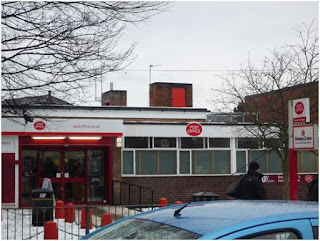The Post Office located at 551, Wilbraham Road, (1) very near its present counterpart was destroyed during the Manchester Blitz of Christmas 1940. It was badly damaged by a bomb.
Chorlton-cum-Hardy's original main Post Office which also took out Martins Bank on one side and tragically at No. 449 on the other killed Mr. & Mrs. Carr and two of their children. Neighbouring properties on what was then Cavendish Road (2) also suffered some structural damage and fatalities.
All that survived the bomb-blast was this porch which probably dated from the middle of the 1890’s when the original residential property was converted into use as a Post Office.
In the immediate post-war years, the structure was incorporated into a new headquarters and function room for the Moss Side Constituency Conservative Party.
This new hall was called “The Fleming Hall”.
Most likely in honour of the recently deceased local M.P. Sqd. Ldr. Edward Lascelles Fleming, who having represented the Withington constituency since the 1931 General Election was, due to some boundary changes, was selected to stand for the Moss Side constituency in the 1950 general election. Just 6 days before polling day he died in Manchester Royal Infirmary on the 17th February, 1950.
A temporary Post Office was opened at the Manchester Road end of Keppel Road opposite the library.
The site was later occupied by offices of the Open University and is now used by the National Health Service
The sorting office was temporarily housed in this building on Wilbraham Road (No. 466).
There were for a time three sub-post offices in Chorlton-cum-Hardy, on Beech Road, Barlow Moor Road (known as Hardy Lane), and Egerton Road South.
The first of these was the one at 109, Beech Road which dates from before the 1901 census. (3)
The sub-postmaster was John Edwin Naylor, who was born in Bradford, Yorkshire (West Riding) in the September quarter of 1866.
He first appears in the rate books for the township of Chorlton-cum-Hardy at 50, Beech Road on the 9th June, 1897.
The rate books also reveal that by April 1899 he had moved to 109 which may indicate that, the sub-post office was opened in the interim.
The “Hardy Lane” sub-post office arrived with the development, in the 1920’s, of council housing on Cundiff Road, Hardy Lane, and along Barlow Moor Road itself.
However, its first manifestation was on the other side of Hardy Lane at 359, Barlow Moor Road where, as recorded in the 1933 Kelly’s directory, Mrs. Ethel M. Kelly kept a newsagents and Post Office.
The row of retail outlets at the junction of Egerton Road South and Saint Werburghs Road were also built in the 1920’s.
However, in neither the Kelly’s 1933 directory nor the 1939 National Register are any recorded as sub-post offices.
The current office is situated at No. 127 and the 1954 Kelly’s directory records Mr. Frank Pearson running a grocery and sub-post office at this same address.
Finally, Chorlton-cum-Hardy has two other links with postal services, one dating from pre-penny post days of the first quarter of the 19th century, the other from the present day.
An early incumbent of St. Clement’s church was Rev. Richard Hutchins Whitelock who was appointed on the 5th January, 1816 and remained in office until his death on the 14th August, 1833. Besides holding other clerical posts, he was also a one-time Postmaster of Manchester.
This building tucked away between McDonalds Drive-Through Restaurant on Barlow Moor Road and Riley’s Sports Bar (Snooker Club) provides the second link. Previously in use as a joiner’s workshop it has for the last 20 years, or so, been a set of offices for the U.C.W. The postal workers union; Union of Communications Workers.
Location; Chorlton
Pictures; The post office 2016, from the collection of Tony Goulding, m 18242 The porch 1961 A. E. Landers, M 17982 A. H. Downes Keppel Road post office 1959, m 18252 A.E. Landers 1959, courtesy of Manchester Libraries, Information and Archives, Manchester City Council, http://images.manchester.gov.uk/index.php?session=pass Egerton Road South sub-post office 2020, U.C.W. offices 2020, from the collection of Tony Goulding
Notes: -
1) Originally numbered “9” Wilbraham Road; at the time of the 1901 census it was occupied by the postmaster James Lucas his wife Adelaide Annie and son, Leonard James, born in 1898. Ten years later he was still Chorlton-cum-Hardy's postmaster and his family had grown with the addition of two daughters; Hilda Bessie Adelaide (born in 1902) and Rita Gwendoline who was just 5 months old in 1911.
In the 1891 census there is no record of a Post Office at this location as 9, Wilbraham Road was occupied by Alfred J. Gilton, a “grey cloth, manager” with a son and two daughters.
2) Cavendish Road is now Corkland Road.
3) Mr. Naylor had been replaced by the 16th April, 1905 when his successor, Robert Chorley, was recorded as living at 109, Beech Road in the baptismal register of St. Clement’s on that date for his son, Geoffrey Croft (born 17th February). Robert Chorley was born in 1864 and was a native of Barrow-in-Furness, Lancashire. His wife, who he married in Kirkby Lonsdale, Westmoreland in the September quarter of 1902, was Hannah Elizabeth (née Croft).

















































